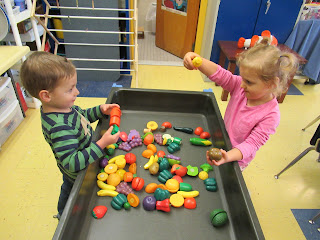Gifts from the Earth Week II was filled with a flurry of
activity! We delivered Harvest Feast Invitations to many of our Parker
Friends! (I hope you found yours in your child's cubby)
We concluded our food drive, and I delivered the groceries to the St. Vincent de Paul Food Pantry in Albany. They were most grateful for the donations. Many thanks for your generosity!
In
correlation with our imminent "soup making," the children engaged in
a variety of fine motor activities depicting vegetables.
We also
concluded our study of Native Americans this week. We made popcorn
for snack, and in lieu of our traditional story time, we gathered around a
pretend camp fire to "hear" stories and sing songs to the rhythm of
our handmade shakers.
Most
importantly, Sarah assisted the children in baking Pumpkin Bread for our
Harvest Feast! Don't forget to send in a Vegetable for our
"soup pot" on Monday! (Soup helpers should also bring a
paring knife.) The children are very excited to host you for lunch on Tuesday!
Divertido con Espanol / Fun with Spanish
Looking Deeper: Exploration and
Learning through Play
This week I would like to guide you through a closer
look at our cooking activities.
Cooking is always a favorite activity among the
children. This may be true because cooking is familiar; it serves as a bridge
between home and school as many of the children frequently cook with their
parents. Perhaps it is because they get to eat the yummy things they
cook. Or maybe it is because there is something magical about
cooking! It looks one way at the beginning, then you mix all this
stuff together and it turns into something different and delicious at the
end! In reality, cooking is a wonderful vehicle for teaching
Science, Math and Language Arts skills to young children! These
activities call for identifying, sorting, ordering, measuring, counting, timing
and observing, while at the same time providing exercise of small motor
skills.
Legend has it that Native Americans invented
popcorn! So we made popcorn this week as one of the final activities of
our Social Studies based study of Native Americans. As the subsequent
photos illustrate, making popcorn was incredibly fun and exciting!
Additionally, making popcorn was the basis of a very interesting Science
lesson! As we began, each child examined their popcorn seed. We talked
briefly about the way it looked and felt. We pointed out that it used to
be part of the cob it grew on, similar to the Indian Corn we have had in our
classroom for the past month.
We talked about how the seed would become
popcorn as we learned the safety rules for using a popcorn popper!
The conversation went something like this:
Teacher: "When I plug in this popper it
is going to get very hot, so we must stand back with just our hands on the
table. What do you think will happen when we put the popcorn seed into
the popper?"
Children: "It will get hot!"
Teacher: "Yes it will get very hot, and
as it gets hot it will get bigger and bigger! Finally it will get so big
that it will ............."
Children: "POP!"
Teacher: "That is exactly right!"
When things get hot they expand, that means they get bigger, and when our
popcorn seeds get as big as they can get they will pop open, and that's when
they become popcorn! So let's watch for the seeds to pop and the smoke to
come out of the holes on top of the popper, we call that steam, and it is very
very hot. You can also use your nose to smell and your ears to hear the
corn popping, and when it is all finished we will have a taste!
The children's faces tell it all; "Science is
fun, interesting, exciting and delicious!
This cooking activity also appealed to multiple
senses, as the children smelled the cinnamon, nutmeg and cloves, and tasted the
chocolate chips before adding them to the bowl.
The photos clearly illustrate that the children were
totally engrossed in each step of making the pumpkin bread! Look closely
and you will notice that all of the children are paying apt attention to the
task at hand regardless of whether they or their friend are performing it.
The interest and excitement was palpable when our
bread emerged from the oven. When returned to the classroom we engaged in
a final "pumpkin bread" conversation. It went something like
this:
Teacher: "Did our Pumpkin Bread look the
same when it came out of the oven as it did when it went into the oven?"
Children: "No."
Teacher: "How was it different?"
Children: "It was wet when it went in,
and it was hard when it came out?"
Teacher: "So it was sort of liquid when
it went into the oven, and it was solid when it came out of the oven?"





















































No comments:
Post a Comment